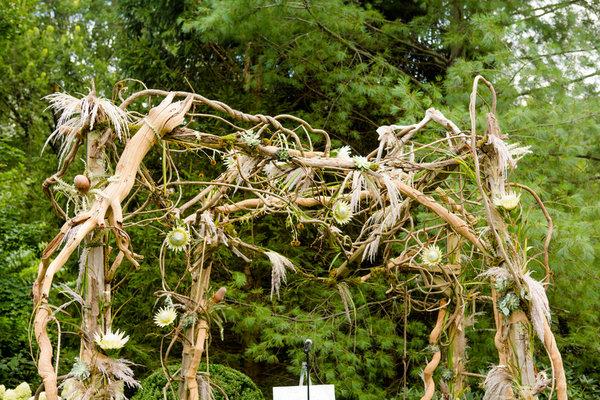When they married last March, Melisa and Justin Monempour stood under an elaborate huppah, which included a 10-by-12-foot flower wall drenched in white roses, hydrangeas and orchids.
“I didn’t want to have a basic cookie-cutter wedding,” said Ms. Monempour, 34, who owns Links Translating Services, a language interpreting company in Los Angeles. “I tried coming up with ideas that would make mine different. I didn’t want a regular huppah, either.”

Couples today are opting for distinctive huppahs, many of which are made from natural materials.CreditDave Robbins Photography
The couple’s huppah served two roles. First, as an important part of the ceremony, symbolizing in the Jewish faith the home the couple would build together. And second, as a photo backdrop, once it was relocated to the ballroom at the Langham hotel in Pasadena, Calif., for their 450 reception guests.
Huppahs, which are canopies that are open on all sides, have been evolving over the years in Jewish ceremonies.
“Traditionally, in years past, the top covering would have been made from a prayer shawl, a tallit,” said Kaya Stern-Kaufman, a rabbi at the Rutland Jewish Center in Rutland, Vt. “The four poles that hold it up would be held by guests of the wedding.”
But, she noted, “In modern times, people have embellished it and made the huppahs free-standing. People have chosen any number of fabrics, or flowers, or natural material, or whatever it is that they want to use, to create the canopy.”
Similar to choosing the wedding site, florist or the couple’s attire, huppahs have become another form of self-expression and personal style, said Andrea Cohen, the owner of Chuppah Studio in Los Angeles. Ms. Cohen’s company services about 70 weddings a year, offering rentals and custom-made huppahs.
“Design is such a big part of our lives in ways that it wasn’t decades ago, or when our parents got married,” she said. “An opportunity to design every element of your wedding, or your home, is a real form of taste and culture. People want a personal iPhone case, so why wouldn’t they want a personal huppah?”
Smashing The Glass, a blog dedicated to helping couples plan their Jewish and “Jew-ish” weddings, has highlighted a variety of ceremony and reception ideas since its 2013 inception.
Karen Cinnamon, the site’s London-based founder and editor, regularly features artistic and beautifully arranged wedding canopies, including huppahs made of driftwood in Corsica, France, grapevines in Healdsburg, Calif., and antique books as pillars with hundreds of light bulbs overhead at the New York Public Library in New York City.
“The groom actually took a light bulb from the roof of the huppah and smashed it,” Ms. Cinnamon said. She referenced another modified Jewish tradition: stomping on a glass (typically wrapped in cloth), after the couple’s first kiss as husband and wife. (That tradition symbolizes the finality of the marital covenant.)
“To me, this is everything a huppah should be — as in, it’s personal,” Ms. Cinnamon said. “It still represents the symbolism of being open on all four sides, and a welcoming home, but it reflects the couple and their interests.”
One-of-a-kind huppahs range in materials and price, though these elements don’t necessarily reflect originality. “I believe that budget has nothing to do with the creativity and styling of a wedding,” Ms. Cinnamon said. “Often low-budget weddings are more creative because they can’t just throw money at everything and tell the florist, ‘Do whatever’s in season, whatever’s the trend.’”
Costs can run from a few hundred dollars to several thousand dollars. Ellen Adelsberg, the owner of Parties by Ellen who oversees eight to 10 weddings annually in the New York City area, South Florida and Israel, says she has planned ceremonies with huppahs totaling $25,000 to $30,000. Some have taken 12 hours, and up to 30 people, to construct.
Despite investing money, manpower and time, huppahs may ultimately be a surprise for a couple.
“Everything else — the centerpieces, the table, the linen — they get to see a sample of how the table will look with the flowers, with the décor,” said Ms. Adelsberg, who has coordinated canopies with Lucite, organized gazebo rentals and relayed specific requests to florists. “Even if you draw out the picture of the huppah, or you give them a gist of ‘this flower will be used,’ really, that day is when you see the project in real life.”
Ms. Adelsberg has inevitably witnessed various fads throughout her 25 years in the industry, but she says that couples today are more interested in having something unique. “The huppah is the most emotional part of the evening, and you want it to stand out,” she said. “People remember it.”







